Born in 1930, Don Waite grew up in Temple City, a suburb east of downtown Los Angeles. His parents had a chicken farm and Don delivered eggs in a 1927 Ford Model-T Roadster. Like many young men of that era, Don was smitten by the racing bug and was soon hacking into the T to lower its stance and make it faster.
The first published photo of his car was a tight shot of the rear end with the decklid open clearly showing the banger in the back. That shot appeared in the August 1948 edition of HOT ROD Magazine. Fitted with a Miller head, Bertrand cam and Wico ignition, the mid-engine Roadster turned 121.25 mph.
In 1949, he placed 5th in the Russetta Timing Association’s Individual Points Championships and third in the SCTA’s. Also, as a member of the Coupes he held the Class C Roadster record that year with a speed of 149.005. However, over in the SCTA, as a member of the Sidewinders, he held the Class C Lakester record at 152.065 mph. Also, in 1949, he set a C Lakester record at Bonneville with a speed of 151.9 mph. Not bad for an 18-year-old kid. According to Don Montgomery writing in his book Hot Rods in The Forties, Waite earned the dubious nickname “The Dumb Kid” from Paul Schieffer. It was actually a compliment because Paul admired the easy-going, full-of-questions, young man who outran all his competitors.
Don’s T proved so popular it appeared on the cover of the September 1950 issue of HOT ROD Magazine by which time it was described as an 160 mph Modified Roadster. A small inset at the top right shows the car looking almost stock but if you look carefully, you can see Don up tight against the dash—the engine was already out back. Inside the magazine there was a three-page feature complete with a Rex Burnett cutaway showing all the details. By 1950, however, Don had swapped the banger for a potent ’47 Merc flathead with three Stromberg 48s. At Bonneville that year Don ran 162.760 mph setting the Class C Modified Roadster record.
What made Don’s Roadster so admired was the cleverly engineered, mid-engine configuration whereby the engine was mounted on a cradle that could be easily dropped so that the engine could be worked on. It was a simple yet effective solution when the 296 ci Edelbrock-equipped engine was under the rear of the body. The frame rails were actually ’29 Chevy separated by Chrome Moly tubing. The front axle was stock ’34 Ford while the rear was a Model A with a Halibrand quick-change.
Perhaps what made the car attractive was the nose, hand-formed in aluminum, as was the louvered decklid, by Whitey Clayton of Bellflower from a cast-off Joe Gemsa sprint car nose. According to Don quoted in Robert Genat’s book Hot Rod Milestones, “He made a pie cut or two, spread it open, and made it wider. Whitey gas welded everything and finished it with files and hammer.” Don went on to describe that when taking the nose home in his ’32 Roadster he got T-boned by a cement truck. The racecar nose was badly damaged and when he got out of hospital he returned to Clayton who, unperturbed, straightened it out for just 10 bucks. The grille was hand-formed steel rod. If you look closely you can see snaps around the grille. They were to secure a cover that aided the car when warming up and kept road debris out of the grille when the car was being flat-towed to races. Of course, Don did a lot of the fabrication himself and also painted the car metallic royal maroon.
Deciding that his Roadster could go even faster, he deepened his relationship with Edelbrock working with Vic Sr. and Edelbrock’s engine builder Bobby Meeks to build a 304 ci flathead fitted with an Edelbrock 4-carb intake, Edelbrock heads and pistons. Don 86’d the track nose and installed a more aerodynamic, shark-like nose on which were emblazoned the words “Edelbrock Special”. Using a little nitro and running in Class C Modified Roadster, the team of Waite & Barnard set a new record at the 1951 Bonneville Nationals of 189.17 mph. That year, Edelbrock-equipped cars set nine new records and attained 13 first places.
By Tony Thacker


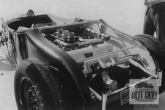
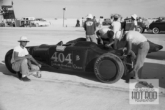


 Justice Brothers
Justice Brothers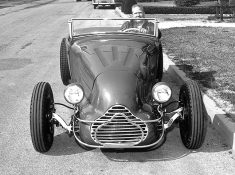 Dick Flint
Dick Flint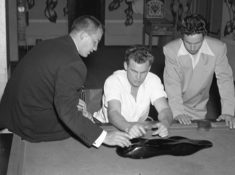 Robert Petersen
Robert Petersen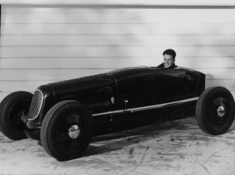 Stuart Hilborn
Stuart Hilborn

